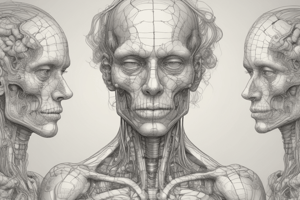Podcast
Questions and Answers
Which of the following is NOT a function of the Central Nervous System (CNS)?
Which of the following is NOT a function of the Central Nervous System (CNS)?
- Control of involuntary movements (correct)
- Regulation of body functions (e.g. heart rate, blood pressure)
- Production of hormones
- Regulation of body temperature
What is the main function of the Cerebellum?
What is the main function of the Cerebellum?
- Regulation of body functions (e.g. heart rate, blood pressure)
- Coordination of muscle movements, balance, and posture (correct)
- Transmission of messages between brain and peripheral nervous system
- Higher-level cognitive functions
What protects the Central Nervous System (CNS)?
What protects the Central Nervous System (CNS)?
- The peripheral nervous system
- The blood-spinal cord barrier
- The Autonomic Nervous System
- The blood-brain barrier (correct)
What is the main function of the Brainstem?
What is the main function of the Brainstem?
What is the main function of the Spinal Cord?
What is the main function of the Spinal Cord?
What is the Autonomic Nervous System responsible for?
What is the Autonomic Nervous System responsible for?
Flashcards are hidden until you start studying
Study Notes
Central Nervous System (CNS)
- Consists of the brain and spinal cord
- Protected by the blood-brain barrier
- Functions:
- Integration of sensory information
- Control of voluntary movements
- Regulation of body functions (e.g. heart rate, blood pressure)
Brain
- Divided into three main parts:
- Cerebrum: largest part, responsible for sensory perception, movement, and higher-level cognitive functions
- Cerebellum: coordinates muscle movements, balance, and posture
- Brainstem: connects cerebrum to spinal cord, regulates basic functions (e.g. breathing, heart rate)
Spinal Cord
- Extends from base of brain down to lower back
- Functions:
- Transmits messages between brain and peripheral nervous system
- Controls reflexes
Peripheral Nervous System (PNS)
- Consists of nerves that connect CNS to rest of body
- Divided into two subsystems:
- Somatic Nervous System: controls voluntary movements, transmits sensory information
- Autonomic Nervous System: controls involuntary functions (e.g. heart rate, digestion)
Nerve Structure
- A nerve consists of:
- Dendrites: receive signals from other neurons
- Cell Body: contains nucleus and maintains cell function
- Axon: carries signals away from cell body
- Myelin Sheath: insulates and speeds up signal transmission
Glial Cells
- Support cells that provide structure and maintenance for neurons
- Types:
- Astrocytes: provide nutrients, remove waste
- Oligodendrocytes: produce myelin sheath
- Microglia: immune system cells that protect CNS
Studying That Suits You
Use AI to generate personalized quizzes and flashcards to suit your learning preferences.




